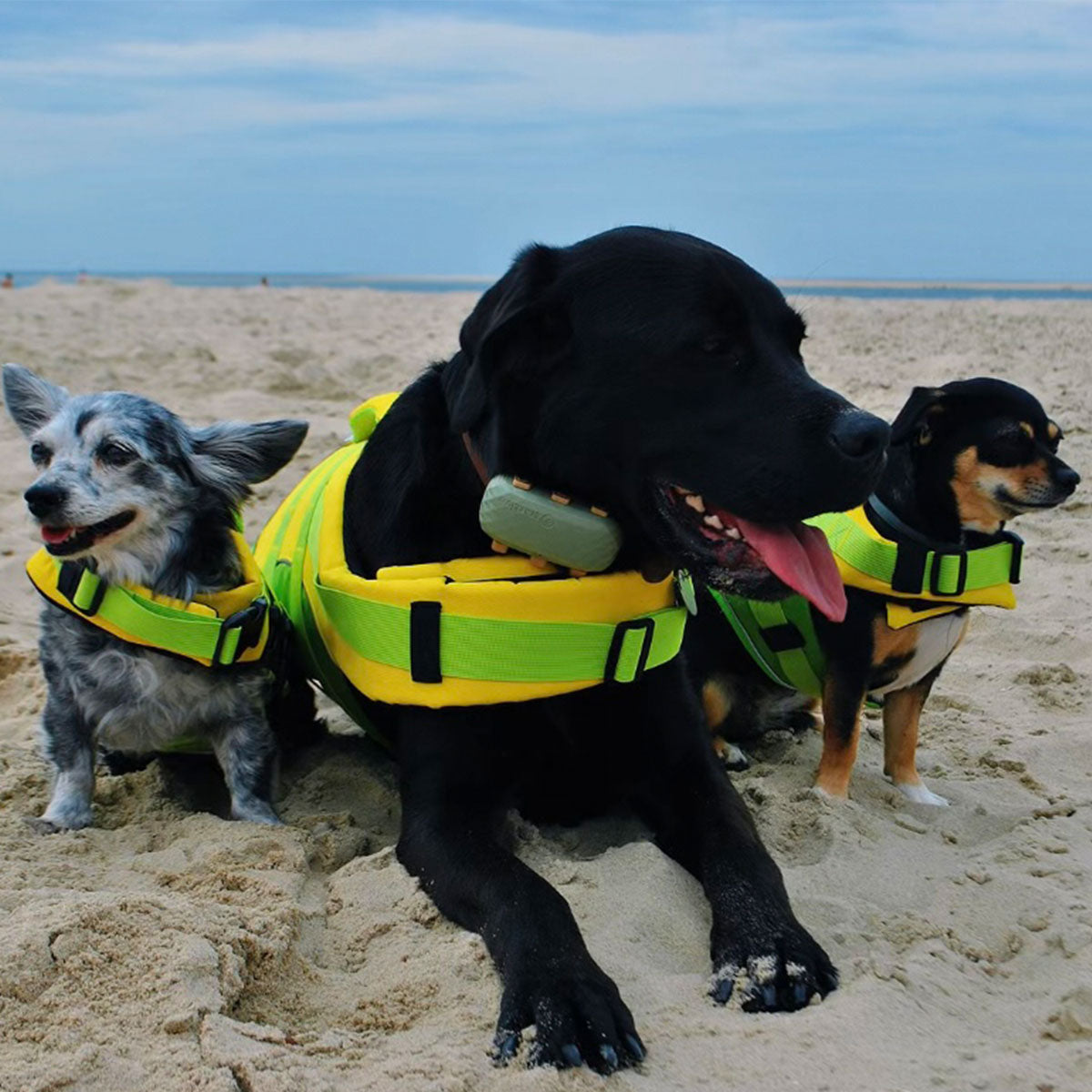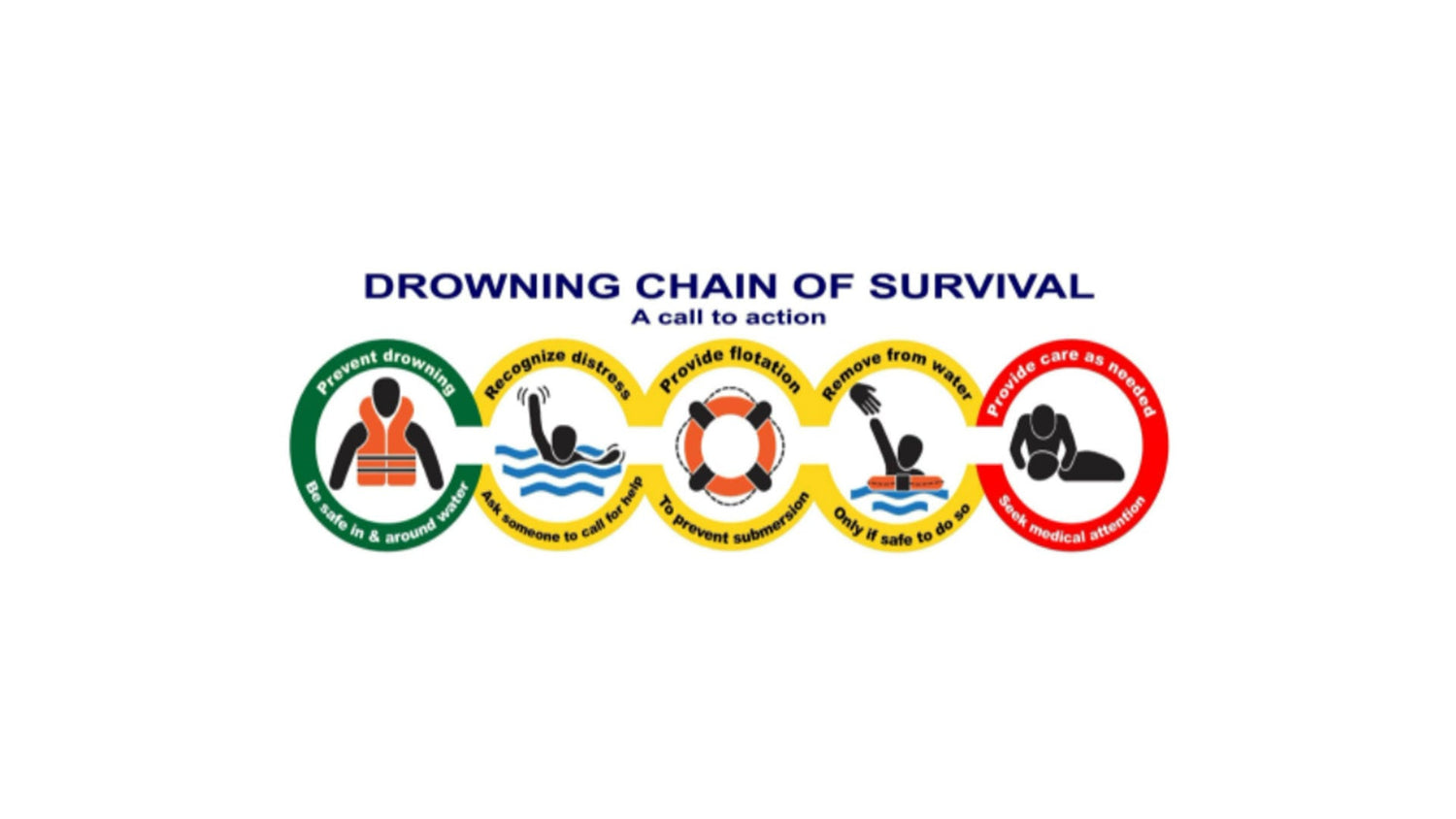A call to action
Drowning is a serious and neglected public health threat claiming the lives of 400.000 people a year worldwide – and still, there are no broad prevention efforts that target drowning.
RESTUBE has set itself the primary goal of raising awareness for the dangers in water. Together with like-minded people and organisations around the world we want to draw more attention on drowning because – as a matter of fact – it is a highly preventable health policy problem. By creating the safety system Restube, that provides buoyancy and visibility for yourself and others in critical situations, we are already making a decisive contribution for people at the ocean, lakes and rivers as well as swimmers and athletes. Ultimately, however, safety in the water is a collective task to which we can all contribute by sharing information and understanding the actions needed to prevent drowning.
Today we would like to introduce you to the Drowning Chain of Survival. The 5-step-plan contains key actions to prevent drowning and helps you to understand how to act effectively in the event of drowning. We also like to show you how Restube can support you in every single step. And we had the great pleasure to speak to Jonathon Webber, one of the leading figures in developing the Drowning Chain of Survival. Read the interview below.
An international study team that includes the NZRC’s Surf Life Saving New Zealand representative Jonathon Webber has come up with a new way to help prevent drowning. The series of simple steps is presented as a ‘Drowning Chain of Survival’. Drowning is the third leading cause of unintentional injury death worldwide, yet there is no globally accepted method to prevent drowning. In ‘Creating a Drowning Chain of Survival’, published in the journal Resuscitation, the researchers describe the development of a universally-appropriate ‘Drowning Chain of Survival’ for the prevention and effective response to drowning. (NZRC)
| Drowning Chain of Survival - recommendation for key actions | How can Restube help? |
|
Restube is so robust and compact that you can wear your flotation really all the time in and around water. If you need flotation just pull the trigger, within seconds Restube inflates and provides instant buoyancy |
| Drowning Chain of Survival - recommendation for key actions | How can Restube help? |
|
Wave with the long yellow buoy or use the whistle to attract attention |
![]()
| While helping others | How can Restube help? |
|---|---|
|
Provide first help with flotation to others with Restube If you are in the water, hand Restube over to the another person |
| To help yourself | |
|
If you are outside of the water, throw the water activated “Restube automatic” to the person in need |
![]()
| Drowning Chain of Survival - recommendation for key actions | How can Restube help? |
|
Get out of the water as quickly as possible: with Restube you can swim fast having no perceivable drag and you can even dive through waves |
![]()
| Drowning Chain of Survival - recommendation for key actions | How can Restube help? |
|
Some Restube models have a small pocket where you can store a mouth-to-mouth mask If you are well trained and a reanimation needs to be done urgently in the water, you can support by giving flotation with Restube |

Photo credit: Michael Craig, New Zealand Herald.
Jonathon Webber
Dr Jonathon Webber is an advanced qualified lifeguard (ret.) and senior lecturer in the Department of Anaesthesiology at The University of Auckland. His clinical background is as a resuscitation officer in a tertiary hospital/trauma centre and he has also worked in various fields of pre-hospital emergency care including community first response, ambulance, and event medical care.
His research interests include human factors and crisis management, simulation in healthcare, resuscitation, airway management, drowning prevention, and aquatic emergency care. A founding member of the International Drowning Researchers’ Alliance (IDRA), he is also a corresponding member of the ILS (International Life Saving Federation) Medical Committee and full member of the ILS Data and Research Committee.
Academic Profile: Click here
Publications: Click here
Jonathon, thank you very much for taking the time to speak to us about the Drowning Chain Of Survival – which we believe is such a big contribution to the understanding of how to prevent drowning and also effectively respond to drowning.
RESTUBE: Can you introduce the Drowning Chain of Survival to our readers who have not heard about it before? To whom is it addressed?
JONATHON: The Drowning Chain of Survival is an injury prevention model, styled in the form of a Haddon Matrix and presented as a pictogram. It describes all the steps in managing a drowning incident from prevention, which is the most important, to providing first aid and resuscitation if required when the person has been removed from the water. The intended audience includes members of the public and lay-rescuers, right through to lifeguards and other aquatic safety professionals, along with any other rescuer in-between.
The model was created to provide a universal international framework for responding to drowning incidents in any aquatic location; endorse and summarise existing models of drowning prevention, water rescue and resuscitation through the use of established messaging and key advice actions; place greater emphasis on the water-rescue aspects of drowning response; and provide a “Call to Action”, that with rescuer safety in mind, empowers those on-scene to do something, rather than nothing.

Restube
Restube is a product for more freedom and safety in and around water. Packed extremely small in a bag, the approx. 200 gram light system can be attached to a belt or directly to the equipment. In an unpleasant situation in the water, with a pull on the trigger the yellow Restube buoy inflates in a few seconds by tapping the built-in CO2 cartridge. The filled buoy gives you time to orient yourself in the water, to recharge, to draw attention by waving with the buoy in signal colour or to help others with it.
It is very easy to swim fast while dragging the long streamlined buoy behind yourself or even dive through waves – its safety leash connects it tight to the hip belt. Back on land, the buoy can be fitted with a new cartridge and used again within some minutes. Restube can also be inflated by mouth. There are three different Restube products – depending on the activity – for private use, as well as two special Restube models for professional rescuers.
RESTUBE: Obviously Restube covers 4 of the 5 steps of the chain: 1. Prevention by wearing a floatation; 2. Creating awareness with the long buoy in signal colour or using the attached whistle; 3. Helping others by passing the buoy on; 4. Lets you get out of the water quickly, because even with a triggered Restube buoy that you pull behind you, you are not slowed down, you can even dive through waves.
But also, what we just recently learned, Restube has helped when in-water resuscitation (mouth-to-mouth) was needed as it provides flotation. As a scientist and water safety professional who has deeply looked into the topic of water safety – what are your thoughts on the Restube idea?
JONATHON: When a person is drowning there are two goals; one strategic, and one tactical. The strategic goal is to remove the person from the water, but the tactical goal is to interrupt the drowning the process and this is achieved by providing flotation. Even professional rescuers tend to focus on the strategic goal but due to the position of the person, e.g., in the surf break-zone, immediate rescue is not always possible.
Another issue is rescuers entering the water with no form of flotation, and this can lead to what is known aquatic victim-instead-of-rescuer syndrome. In this situation, typically the person in distress survives, and the would-be rescuer drowns. This is where a purpose-designed tool device such as Restube, or an improvised flotation device is essential for rescuer safety, which the priority in any drowning incident.
RESTUBE: Since 2014 when the Drowning Chain of Survival was published, what has been done in order to implement it? How do you make it public, accessible for people (in an educational way)?
JONATHON: The Drowning Chain of Survival has been adopted by the International Life Saving Federation (ILS), European Resuscitation Council, and numerous other water safety organisations and first aid training providers worldwide. The graphic now appears in training materials, e.g. textbooks, public signage next to water hazards, and is also used in water safety education programmes. The best example of this is in Brazil, where it is the foundation for water safety education as you can see in the picture below:

RESTUBE: In your opinion, what should people do, what are the necessary actions to have good time around water and to be prepared just in case?
JONATHON: People need to think about what could go wrong; it’s as simple as that. They also need to be adaptable and revise their plans if necessary. When they get to wherever they are going, if the conditions have changed, appear dangerous, or they are in any doubt whatsoever, they need to do something else that doesn’t include entering or being around the water. The problem, however, is that hardly anyone ever thinks about being involved in a drowning incident themselves or called upon to help a family member or another person when they pack their car to head off to the beach, lake, or other aquatic location. In many places that people recreate in, on, or around water, no rescue services such as lifeguards are immediately available. While being able to perform a water rescue requires specific training, I would sooner untrained rescuers had access to rescue/flotation devices like Restube rather than enter the water with nothing.
RESTUBE: What do you wish for in the future? What are the major changes which need to happen in the world in order to significantly reduce the deaths caused by drowning?
JONATHON: Communities, governments, and all of us as individuals need to better understand the true social and economic burden of drowning, which in most cases is entirely preventable. One avenue for this is better research and evaluation of drowning prevention initiatives. Other forms of injury prevention typically receive more publicity and funding, and in some cases are easier to tackle because, as is the case with motor vehicle trauma, there are engineering solutions, for example, that can make cars and roads safer. Drowning is more complex because of the disparate nature of how and where these events occur. In many low- and middle-income countries, drowning is directly linked to sustenance activities like gathering food and children being left unsupervised.
RESTUBE: People think that drowning is only a concern of low-income countries, is this statistically true?
Even high-income countries, drowning is still a leading cause of unintentional death. Thus, a multifaceted, multiagency response is needed that is tailored to the needs of specific communities and high-risk groups is needed rather than a “one size fits all” approach. There are plenty of good examples worldwide of drowning prevention programmes and these experiences should be shared widely to see if they can be applied at the local level to address the specific needs of the target population.
RESTUBE: How relevant are natural disasters concerning drowning?
We also need to reassess our preparedness and response to natural disasters. These events seem to be occurring more frequently, and in my view, we need to do more to ensure those countries/regions prone to flooding and tsunami etc. are in a better position to cope when these disasters occur. This, hopefully, will go some way to reduce the number of deaths caused by drowning globally.
Conflict of Interest Disclosure
Jonathon Webber is the owner of AquaSafe New Zealand, an Auckland-based aquatic safety company that sells water rescue/resuscitation products and also Restube.




